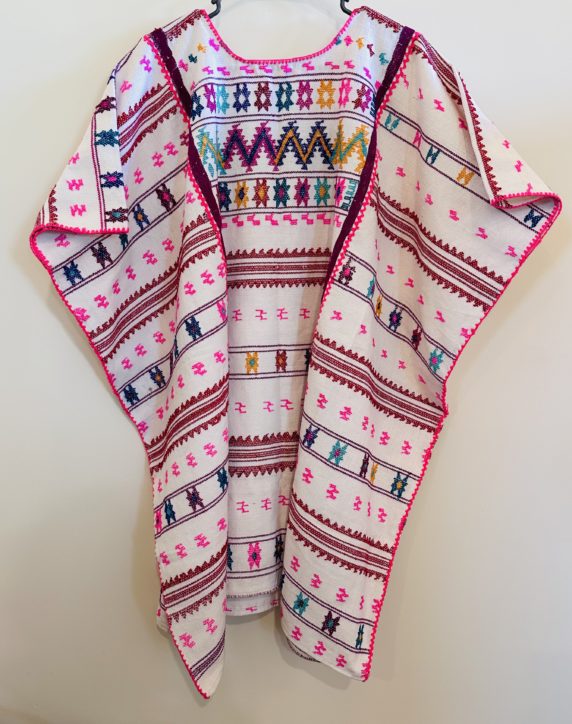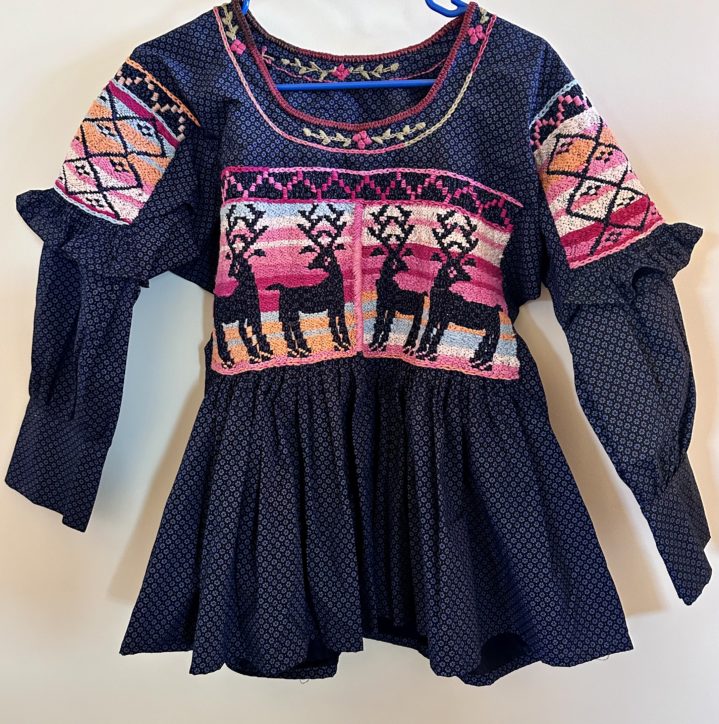Patti wrote to me in response to my post about Day of the Dead Etiquette and Behavior. It is so touching and expressive that I asked permission to share it with you. Here it is.
Dear Norma,
Over 20 years ago, I lost my sister to cancer, and her husband just a few years after that. We had been to the Yucatán in 1990 together and always assumed we would some day travel to Oaxaca for Dia de Los Meurtos. Unfortunately, I never traveled with them again.
I work in Olympia, Washington, at a small art gallery that features primarily Northwest artists. One of our long time print makers went to Oaxaca de Juárez six years ago to create and learn from local print makers after meeting Edgar Martinez from Oaxaca, who now lives in our area. Together, they were able to bring up almost 100 prints from 25 Oaxaca artists to sell at our gallery. We fell in love with the artwork and were touched by the history and background of the protests and struggles of the teachers ( Mimi Williams, who was our resident printmaker, was a teacher herself ) whose story the printmakers were able to bring to the attention of the world. The exhibit was wildly popular and educating. I translated all of the titles and found myself reading everything I could to learn more about their meaning. traditions, archaeology, folklore, geology animals, rituals…I drank it in. I found your blog and have read every entry at least once.
Five years ago, my husband Roger and I were blessed to carry out the dream of my sister, Lynda and brother in law, Bob, and fulfill their dream. We were able to see the build up to the holiday, visit most of the cultural sites, experience markets, museums and of course visit all of the print shops. I brought with us postcards and media info on our exhibit and was able to meet almost every artist we had represented. This was a thrill for both myself and the artists. Of course, we came home with many new prints!
We spent only two days in Teotitlan de Valle where we felt a bit out of place at first, but quickly realized we should have spent more time. We visited the beautiful pantheon as the villagers worked decorating their loved ones gravesites, heard the church bells ring, the fireworks at 3:00 pm, the scent of chocolate and tamales in the air, and see all of the flower filled moto-taxis en route to alters and the cemetery which we visited early in the day. There was only a small tour group of six there that were very respectful. They appeared to be the only other tourists. What I felt was no coincidence; I struck up a brief conversation with an older woman, and then was approached by her husband who recognized me from my former occupation, working at a plant nursery in Olympia! This was just one of many coincidences we experienced. Norma, my family was raised without religion, but open to spirituality. I hadn’t felt closer to my lost loved ones than when we were walking the streets of Teotitlan de Valle. The warmth and welcome we received was nothing short of magical, and I felt Lynda and Bob’s presence every step.
We went back to the big city and met with the guide we had for several days and had an amazing experience with the first week. He convinced us we should go on a cemetery tour that evening. This was the single most poor choice we have ever made traveling. At first, lost in the beauty and excitement we took a few photos, but then chose to exit and wait for our group outside the gates. The inappropriate behavior, sexy party clothing, open drinking and pure disrespect made us feel sick to our stomachs. Literally.
Well, that experience left a sour taste in our mouths, but we chose to go back again in 2021. This time, we took more time to simply wander the streets and neighborhoods a bit further out, eat at smaller less known “risky” restaurants, and if course revisit the print shops and artists when we were in the big city. We then spent four days in Teotitlan de Valle. We stayed at the same little hotel, Teocalli, and met up with the rug maker who treated us like royalty and had us stay for lunch. He arranged for his nephew to guide us up El Picacho, which was breathtaking, and an education even though we really don’t speak Spanish and our guide no English! We were taken to our innkeepers home for delicious snacks and beverages made by all three generations of women in the home.

That night I was attempting to ask the innkeeper’s husband where we could purchase cerveza for our ofrenda so late in the evening. A pleasant friend of his, who spoke English offered to take us to a store. Breaking every travelers rule in the book even during a non pandemic year, we got into the vehicle with this stranger, and drove off. Well, not only did he take us to the store, he asked if he could drive us to his home and show us his own alter. Keeping in mind, we had left the door to our room wide open, with my purse, our laptop and extra cash in plain sight. We spent almost four hours sitting in front of their ofrenda, shared mezcal, nuts and stories with his wife and son. Before we left, he made sure that we had fresh tortillas (both large and small for angelitos ), nuts, more chocolate, freshly made tamales, all in a handwoven basket his wife gave as a gift, and a HUGE bundle of Fleur de Muertos, which we were told, was more important than cempasuchil in their village. He drove us back a bit tipsy, stopping to say hello to every person still out and about. Of course, our unlocked room was just as we left it.
We set up as proper of an altar as you can in a place that is not your own home, and walked to the cemetery. We only sat outside under the tree and observed. We did not go in. We saw both the beautiful and obnoxious side of this important holiday. We retired to our room, lit a few candles, drank a couple of cervesas and talked about each loved one whose photo we placed and snacks we set out for. Two days later when we left, the gentleman whose home we had spent time in, happened to be driving by and saw us. My husband asked if he wanted to come in and see our ofrenda. He left the car running in the street, came inside, and actually started to cry telling us it was perfect! Of course, this made both of us cry as well. We hugged and said our farewells and thank you’s. Before we exited to go back to the city, another rug maker we spent a few hours with insisted we ride with him and not call a taxi. It was a memorable drive back and consider him a friend now as well.
Last week, we once again created an alter in our Pacific Northwest home. We added two photos this year. Very bittersweet. Again, not being raised in an organized religion, we both feel such a driving force to carry out this yearly ritual now. We are pleased that we had the blessing of doing so from the native people we met and now consider friends.
I realize this is quite a long message, but I’ve been wanting to write and thank you for a few years now, for guiding us through our travels to this amazing part of our world. The experiences and the opportunities that were presented to us left no doubt that the spirits of our dear Lynda and Bob indeed made it to Oaxaca and joined us, guided our travels and celebrated life with us. We hope to go back again and join you on a tour some day.
Thank you for all you do. You are my hero. Keep up the great work!
Cheers!
Patti White







Day of the Dead Etiquette and Behavior: Teotitlan del Valle Cemetery
Last year, 2022, Day of the Dead in Teotitlan del Valle was a frenzy. Big tour buses and mini-vans each holding 24 to 36 passengers unloaded face-painted visitors in front of our cemetery. I had made a plan this year to go early and not stay very long, expecting the same thing — travelers looking for mezcal shots, pointing their cameras in locals’ faces without asking permission, and having a roaring good time. I noted that tour guides had not prepared the visitors for an experience that included cultural sensitivity and respect. In 2022, foreign visitors outnumbered village residents two to one.
This year, I was very surprised to see only one face-painted visitor, no buses or vans, and very few tourists between 5 and 6:30 p.m. I thought, perhaps it was because the village municipal authorities made a policy to collect a toll from the buses and vans.
Oh, but how I was misled! My good friend Ani, who has been living here since 2003, went to the cemetery to pay her respects to our dear friend Juvenal, who died from Covid at the front end of the pandemic. He was fifty-two. She reported to me that the buses and vans showed up at 7 p.m., disgorging revelers who came to party. I narrowly escaped the assault.
The benefit of visiting earlier is that I saw Teotiteco familes enjoying the balmy fall evening, sitting around the gravesites of their loved ones, telling stories, eating peanuts and oranges, maybe taking sips of mezcal or beer. I mistakenly assumed that the panteon had returned to how it was pre-Pandemic.
So this brings me around to visitor behavior and etiquette for visiting cemeteries in Oaxaca for Day of the Dead.
If anyone has any other tips or comments they want to add, please send me an email and I’ll publish them. Thank you for reading and listening.
Like this:
3 Comments
Posted in Cultural Commentary, Travel & Tourism
Tagged behavior, cemetery, culture, day of the dead, etiquette, Oaxaca, panteon, respect, tourism, tours, travel